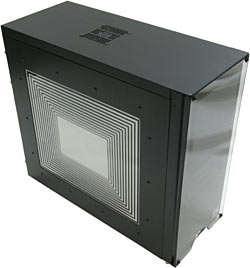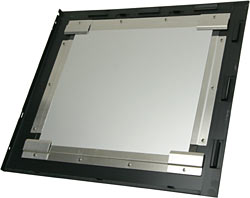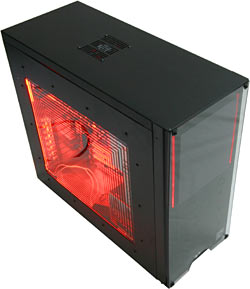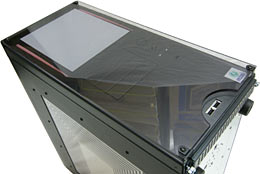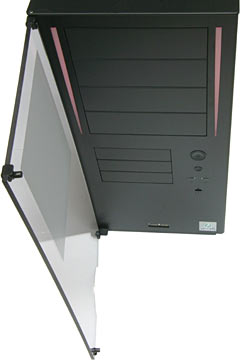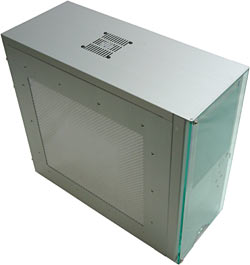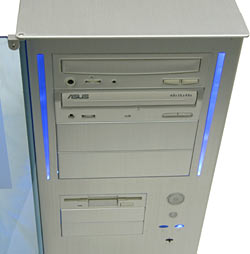
Lian Li PC-6087, PC-6089 and PC-6099 PC cases
Review date: 4 September 2002.Last modified 03-Dec-2011.
Lian Li are the original flashy aluminium computer case company, but they're not the only people making high-priced, nice-looking PC cases for the discerning buyer. Cooler Master have been encroaching on Lian Li territory for some time, with neat-o brushed aluminium boxes featuring glass-look acrylic front panels. And they're not the only ones.
Cooler Master are in Lian Li territory as far as practicality goes - their cases are nice to work on, as well as nice to look at. No sharp edges, easy access to components, thumbscrews to reduce screwdriver usage, and so on. You'd bleeding well expect this kind of convenience for the money, mind you; the delivered prices for the acrylic-fronted Cooler Masters are well over $AU550. Lian Li cases are rather cheaper here in Australia than they are in the rest of the world, but the same can't be said for Cooler Master boxes.
Lian Li now have a line of "PC-60xx" cases that have see-through front doors, just like the Cooler Master products, but which also have a few extra pretty-features of their own. While, of course, retaining the Lian Li look and feel that many users, me included, have come to rather like.
The new PC-6087, PC-6089 and PC-6099 cases are only cosmetically different. So I'll show you around the funky black one, and then give the other two a quick run-down.
The PC-6099
Hard-anodised black aluminium exterior, clear acrylic front door with a frosted area over the 5.25 inch drive bays, funny looking side window. $AU440 from Aus PC Market here in Australia, including Sydney metropolitan delivery; shoppers from outside Sydney will pay more for shipping. That price doesn't include a power supply, but it does include a T-3B dual display temperature module, which sells for $AU66 delivered by itself. Unfortunately, that isn't as great a bonus as you might think, for the reasons I explain here.
Apart from the trimmings, this and the other PC-60xx-series cases are functionally almost identical to the benchmark standard PC-60 series. They've got four 5.25 inch drive bays, all with a front panel cutout, plus four 3.5 inch bays with cutouts, all in a removable cradle, and another five 3.5 inch bays without cutouts, in another removable cradle that sits below the middle 3.5 inch bays.
Those bottom internal 3.5 inch bays sit right behind the two standard speed-controllable 80mm front intake fans, and there's also one top and one rear exhaust fan. Everything's made of aluminium, everything fits well, everything you're likely to need to access often is held in place with thumbscrews so you probably won't need a screwdriver, and there's a slide-out motherboard tray, too.
The PC-60xx cases are all 210mm wide by 450mm high by 490mm deep (8.3 by 17.7 by 19.3 inches) and, like every Lian Li enclosure, they're surprisingly light as you lift them out of the box, thanks to their aluminium construction. The light weight's close to irrelevant in the real world, though, because once you build an actual computer into you're not likely to notice the difference. Still, it doesn't hurt.
Now, let's have a look at that window.
The purpose of acrylic windows in the sides of computer cases is to allow the intrepid performance computing extremist to display his or her shiny hardware, generally lit up like a Mediterranean disco.
This window, as it comes out of the box, won't let you do that. It's got an aluminium plate behind it.
The obvious question this raises is "why, in heaven's name, would anybody put a window in the side of the case and then blank it off on the inside with a slab of metal?"
The answer to that question is "so that they can legally sell the cases".
The trouble with computer cases made partly, or entirely, of plastic, is that plastic doesn't do anything to stop electromagnetic radiation (EMR) from the components inside from getting out. Or to stop outside radiation from getting in, for that matter, but that's hardly ever a problem.
PCs are significant sources of EMR, as anybody who's set up an indoor TV antenna in the same room as a computer is likely to know. And the less metal you have around the components, the more energy will escape.
Some people get very excited about the possible health implications of sitting in a relatively-high-EMR environment, but the only provable problems PC emissions case are with TV and radio reception, plus any other nearby gadgets that're sensitive to EMR at the frequencies the computer emits.
Most countries have, accordingly, quite stringent rules about EMR emissions, to stop people from selling poorly shielded gear that screws up TV reception (and worse) for all of the neighbours of the user.
Companies that sell computer cases with big holes in them, therefore, probably ought to be a bit circumspect about it. None of them have been until now, as far as I know, but that doesn't mean they shouldn't be.
There isn't likely to be anything illegal about selling a box with no computer inside it which, if it does by some strange chance have a computer put inside it by someone, will violate every EMR standard in your country, everybody else's countries, and the secret Illuminati republic on the far side of the Moon. The Bootleg Cable Descrambler Salesman's Excuse - "But I clearly explained to my customers that my products are meant only to be put on the mantelpiece and admired!" may profitably be employed.
But, nonetheless, if you're in the business of selling things that can't be legally used for their intended purpose, I'd say it's not a bad idea to tread lightly.
Hence, the aluminium plate.
With it in place, the PC60xx-series cases are as solidly shielded as anybody else's, including Lian Li's own window-free products.
If you want to throw caution to the wind and remove the plate, though, it's easy enough to do. Just undo the Phillips head screws that hold the plate-retaining clamp pieces in place, and it lifts right out...
...whereupon the PC-6099's ready to party.
You don't get an interior light with the PC-6099 package, but they're not hard to find; Aus PC Market sell cold cathode fluorescent light kits for $AU49.50 delivered.
Even without some kind of caselight, though, you'll get more light out of the PC-6099 than you might expect, thanks to the two glowing tapered strips on the front panel. They're each lit by a factory-installed high intensity LED, which runs from the PC PSU.
The PC-6099 front panel, clearly showing the frosted rectangle over the 5.25 inch drives. The frosting does a bit to conceal beige drives marring your zooty black case, but it doesn't hide them completely.
Note also the little cut-out at the bottom of the door, for the two USB ports. Like other recent Lian Li cases, this one gives you front USB ports, and they're USB 2.0 compliant. Which is good. To make them work, though, you'll have to connect four wires terminating in three tiny plugs to the appropriate headers on your motherboard, the pinout for which ought to be in the mobo manual, but might not.
I have done this successfully. Others have failed. Good luck.
The PC-60xx front panel isn't removable - well, not just by pulling it off, as you can do with almost all other Lian Li cases. It's screwed in place, and you have to pop out the door before you can get at all of the screws.
Because of this, and because of the un-perforated front door, the foam air filter for the front fans had to be redesigned. The fans aren't just sucking air from directly in front of themselves any more, and the user has to be able to get at the filter reasonably easily for cleaning, lest it turn into a solid rectangle of foam-backed dust-felt.
Because of this, the PC-60xx cases have this narrow perforated strip at the bottom of the front panel, which is held on by a couple of thumbscrews...
...and which, when removed, reveals a rather small fan filter.
The fact that this filter is right at the very bottom of the front panel, and is so small, suggests to me that it'll clog up really quickly if you put the case on the floor in a normal room. The front panel isn't exactly hermetically sealed; there are other ways for air to get to the intake fans. So a clogged filter won't be the end of the world. Just the same, though, the PC-60xx cases can't possibly be as well ventilated as Lian Li's other twin-front-fan models, which all have a much larger filter.
Lian Li cases are generally overventilated, though. I've seen boxes with even more generous air flow (heck, I made one once), but even with the front fans at minimum power, you're really not likely to have any overheating problems if you haven't totally stacked the case with hard-working gear and put it somewhere with a higher than usual ambient temperature.
Below the PC-6099's matte black power and reset buttons, and the oval lenses for the power and hard drive LEDs (power light blue, drive light red, both lights high intensity units that light up the opposite wall at night, of course), is the switch for the three-position fan speed controller. This is another thing that's behind the front panel in most Lian Lis; it gives you the option of full power, about two-thirds power, and about two-fifths power, from the two standard medium-to-low-power fans.
The PC-6099 I checked out used a magnetic latch for the front door - there are a couple of small but powerful magnets behind the front panel, and a couple of matching steel pegs on the corners of the door. This closure holds pretty well, but an ejecting drive should be able to bump it open.
I'm not sure what kind of latch Lian Li are actually settling on for the PC-60xx cases, though, because the PC-6089 I reviewed had a magnetic latch too, but the PC-6087 had one of those tricky little plastic push-to-close, push-to-open widgets. This latter latch won't release if an ejecting drive's pushing on the front panel, but all decent drives should give up in short order if they're obstructed, so no harm should come to anything.
Lian Li products often have minor differences between different production runs of what's nominally one product, but since the magnetic latch is definitely niftier, I imagine they're transitioning to that for all of the PC-60xx cases.
I wouldn't bet more than ten bucks on that, though.
And now...
The other two
The PC-6087 has Lian Li's trademark plain brushed-metal hard-anodised finish, a greenish door on the front, and a different pattern (square grey dots) printed on its side window. Apart from that, it's the same as the PC-6099, except it doesn't come with one of their questionable T-3 temperature monitoring gadgets (hurrah!), and it costs a bit less - $AU429, including Sydney metro delivery, from Aus PC Market.
The front panel, featuring the push-clip latch I mentioned above.
Here's the PC-6087 powered up, showing off its front lights. Blue, this time. The almost-not-beige drives installed in this case look the way that they do because of some of Lian Li's stick-on aluminium front panels.
And here's the PC-6089. Same price as the PC-6087, same finish on the metal, but with square blue dots printed on the side window, and a blue front panel.
This one's had its side panel plate removed...
...for another glamour shot.
The printing on the side windows is crisply done, but frankly, I think I prefer plain clear ones. Your tastes may differ.
Overall
If you want a Lian Li case that's functionally identical to these ones and don't want a window or a door, get yourself a PC-60USB. That's still an expensive case - $AU297 without PSU from Aus PC Market including Sydney delivery - but the price difference between the PC-60USB and the two cheaper PC-60xx cases is still almost enough for a quality 256Mb DDR memory module. Which, frankly, is something that I think you'll get more use out of than an acrylic front door and a dotty side window.
If you like the look of the PC-60xx cases, though, they're not preposterously more expensive, for what you get. They're as nice to work with as any other Lian Li, their tiny fan filters probably won't be a big problem, and if you ask me, they manage to score high on the show-off charts without tipping over the edge into mug lair territory.
If you don't care what your computer looks like, no Lian Li case is a great idea. You'll do a lot better, even if you spend a lot of time tinkering with the machine, with a far cheaper quality steel case like this one.
If you're committed to building a zooty new impress-your-friends PC, though, a PC-60xx case may be just what you need. It doesn't cost that much compared with the price of all of the components that'll be going into it, and it's as easy to live with as it is flashy.
The PC-60xxs are, therefore, recommended by me. But only to certain people.
We know who we are.
Buy stuff!
Aus PC Market no longer stocks these cases, but they've got
plenty of others!
(If you're not in Australia, don't bother - Aus PC won't deliver
to you.)
